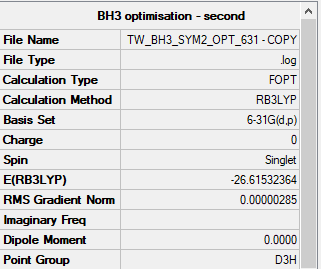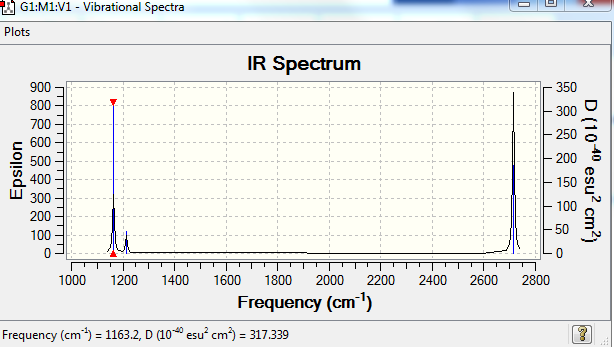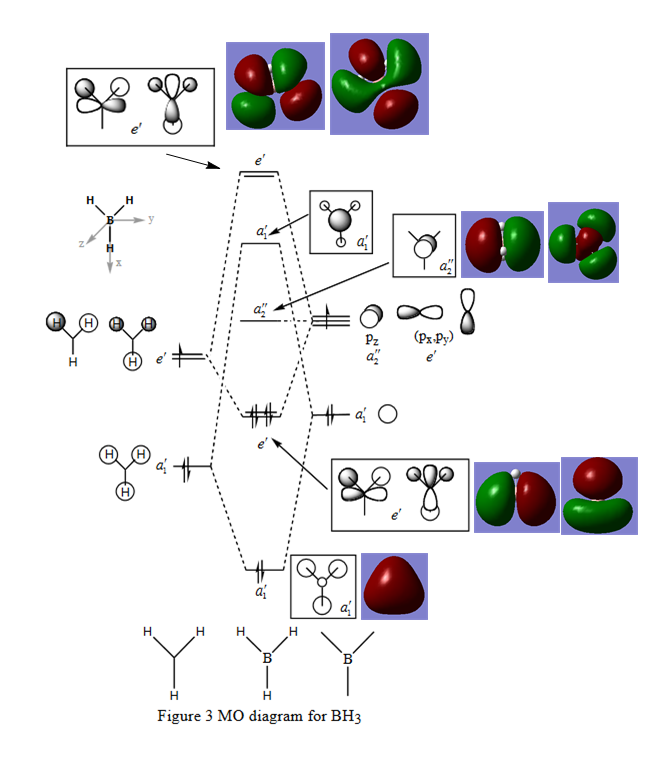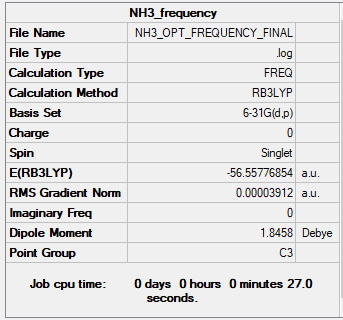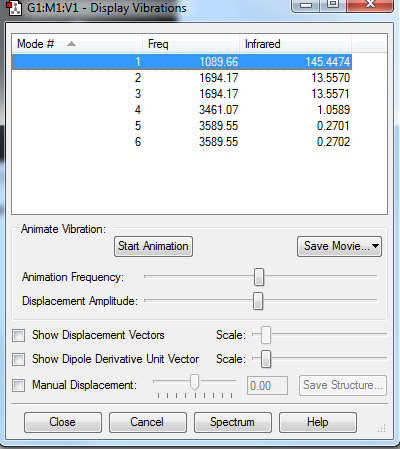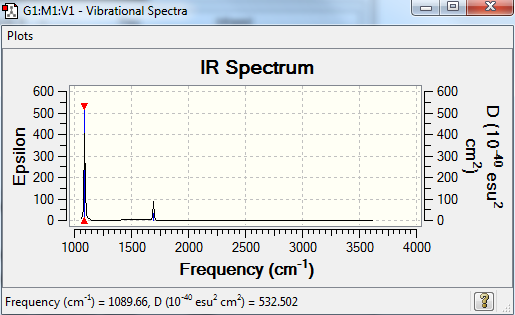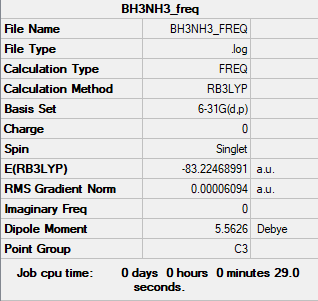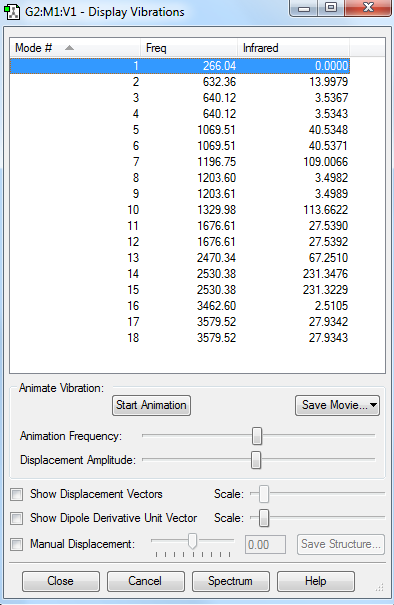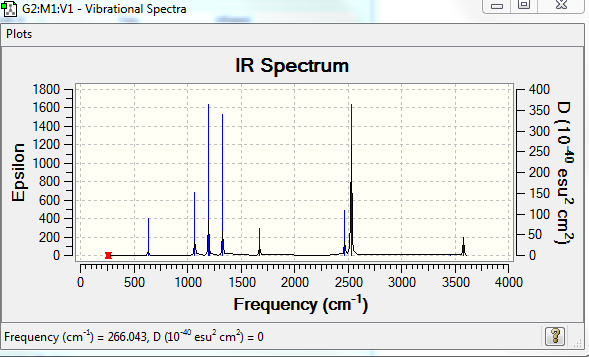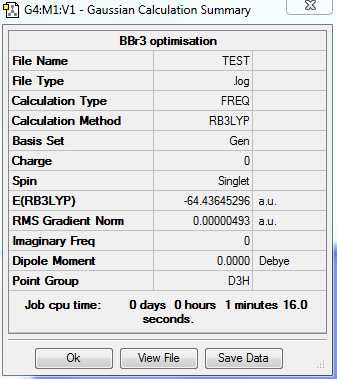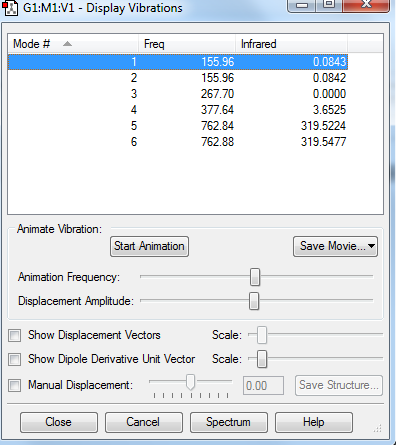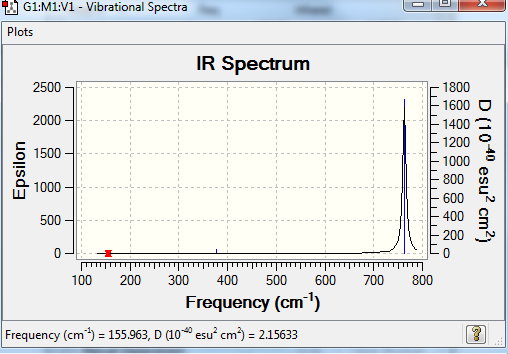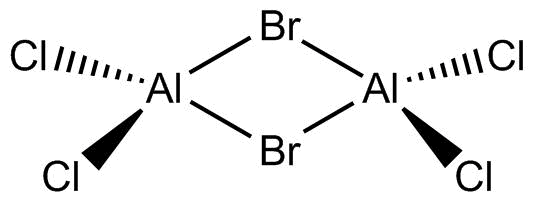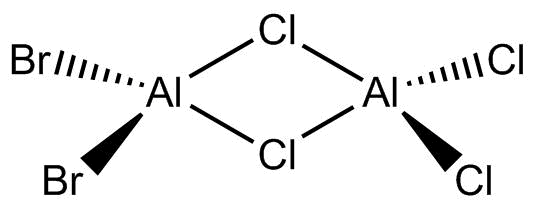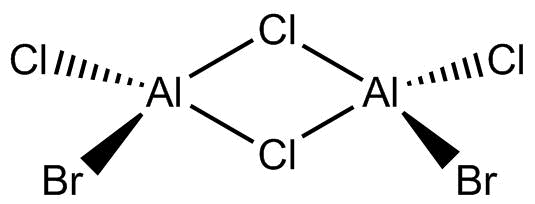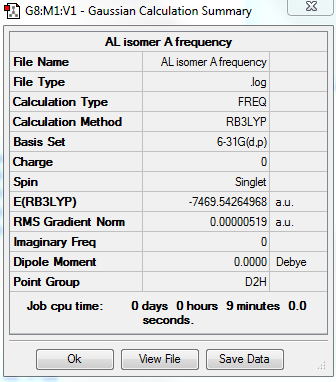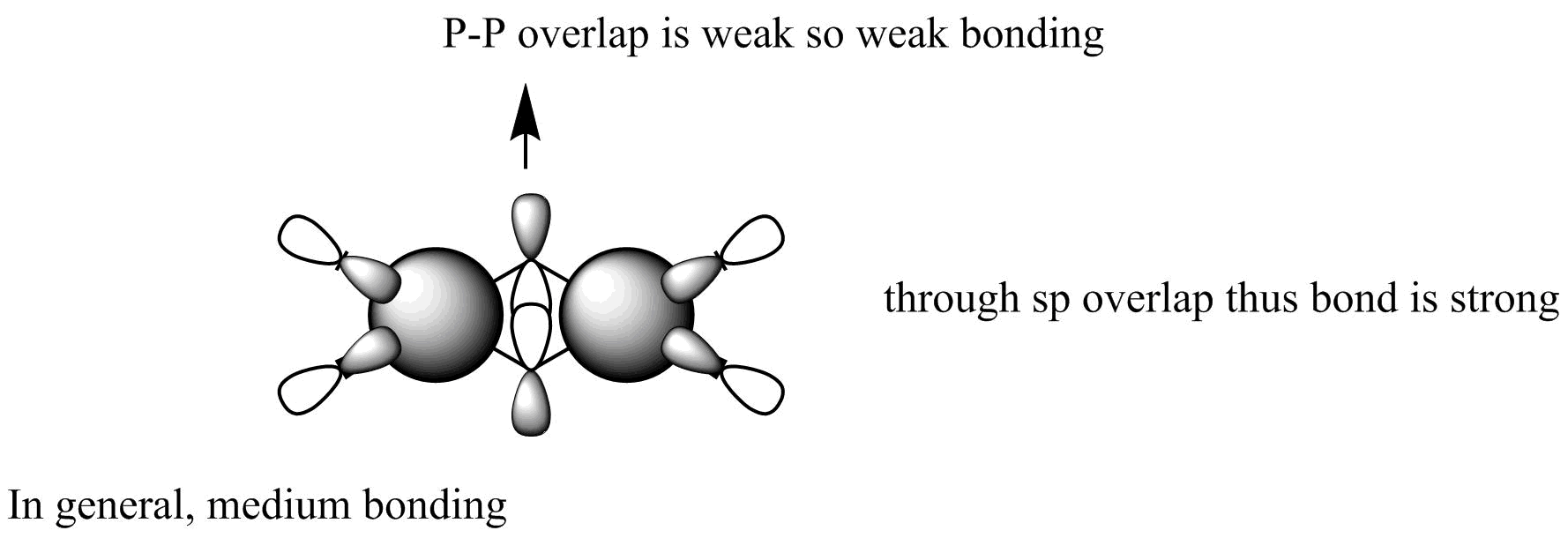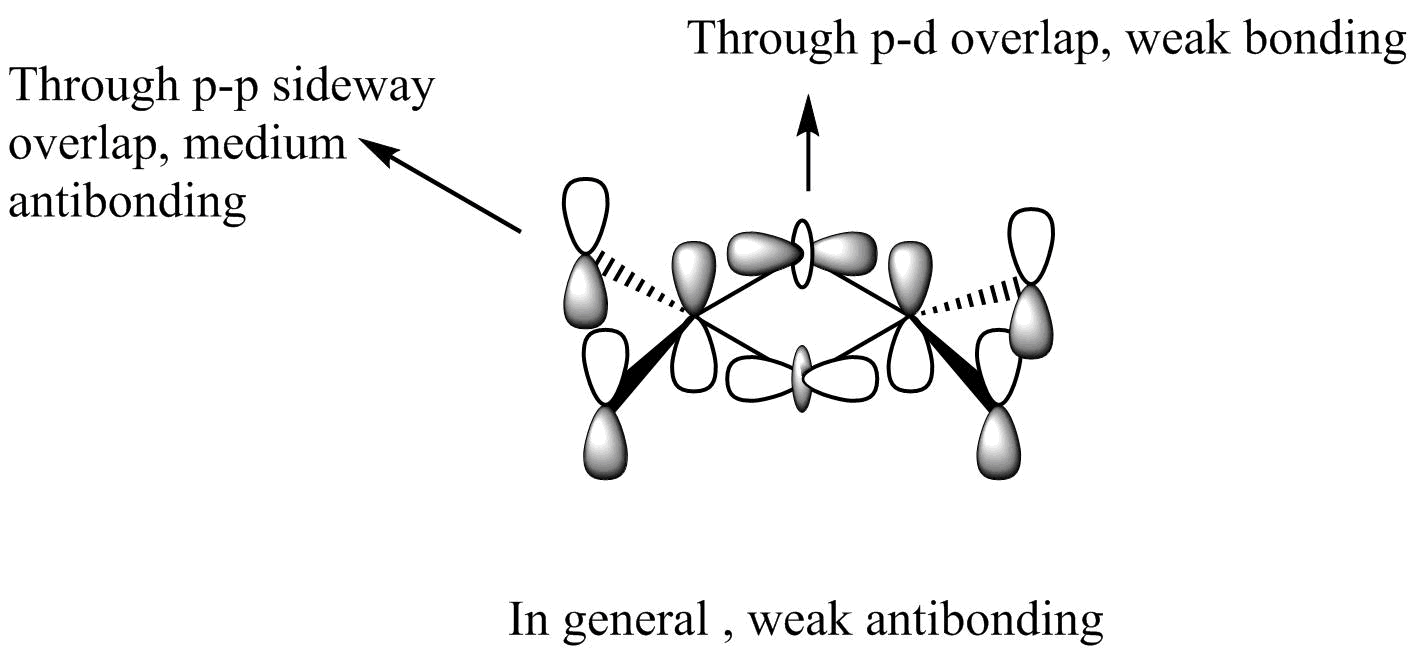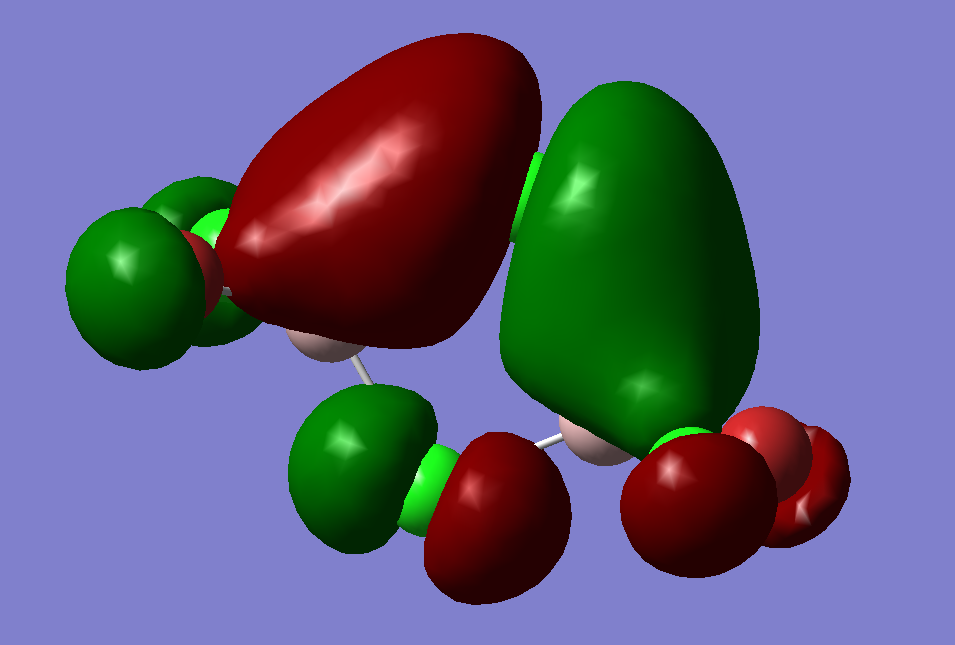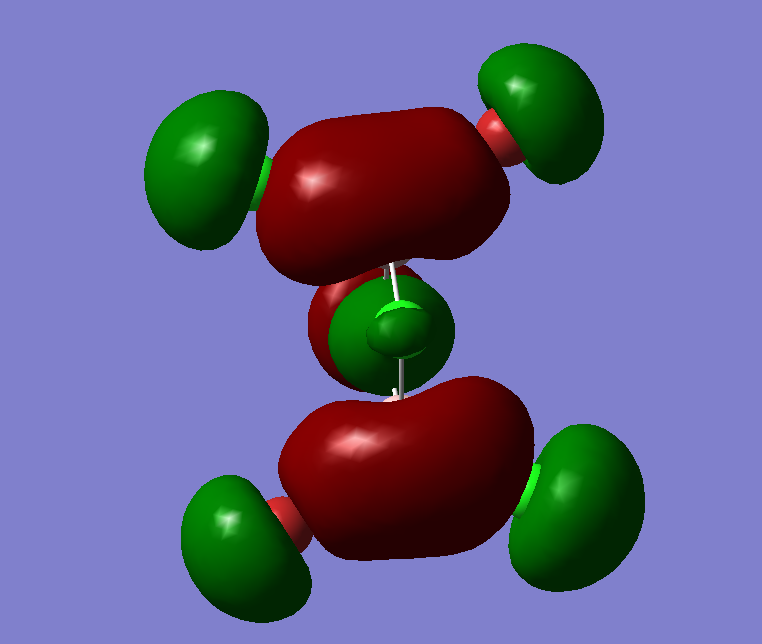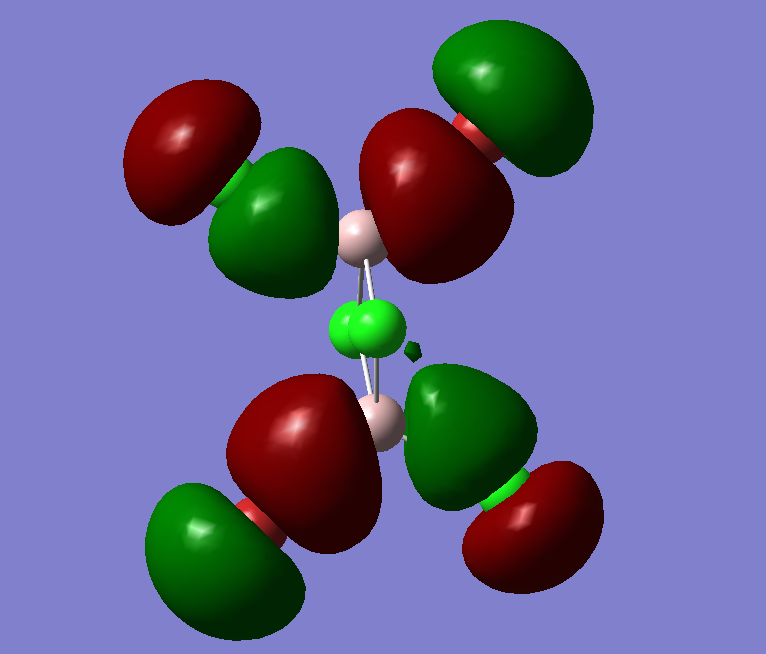Zz3116
BH3
B3LYP/6-31G(d,p)
Item Value Threshold Converged? Maximum Force 0.000049 0.000450 YES RMS Force 0.000024 0.000300 YES Maximum Displacement 0.000192 0.001800 YES RMS Displacement 0.000096 0.001200 YES
Frequency file:Media:ZZH_BH3_FREQ.LOG
Low Frequency Lines
Low frequencies --- -0.3988 -0.1915 -0.0054 25.8734 27.8200 27.8229 Low frequencies --- 1163.1999 1213.3197 1213.3224
BH3 molecule |
IR of BH3 molecule
| Mode | Freq | Intensity | IR active ? | Vibrations |
|---|---|---|---|---|
| 1 | 1163 | 93 | YES | bent |
| 2 | 1213 | 14 | YES | bent |
| 3 | 1213 | 14 | YES | bent |
| 4 | 2582 | 0 | NO | bond stretch |
| 5 | 2715 | 126 | YES | bond stretch |
| 6 | 2715 | 126 | YES | bond stretch |
Ng611 (talk) 14:19, 31 May 2018 (BST) What you have is good, although you should add a column containing symmetry labels as well as these are important features of any vibrational transition.
There are two sets of degenerate vibrations, one is bent and the other is bond stretch, thus 3 peaks are observed in the spectrum.
Ng611 (talk) 14:19, 31 May 2018 (BST) Well done for noticing the degeneracy. With two degenerate sets of vibrations, one would expect to see four, not three lines. Yet only 3 are observed. You need to explicitly mention and explain why mode 4 in your table is IR inactive.
MO diagram of BH3
Reference: MO diagram is from tutorial pdf.
Questions: Are there any significant differences between the real and LCAO MOs? YES What does this say about the accuracy and usefulness of qualitative MO theory? MO theory is useful and highly accurate.
Ng611 (talk) 14:20, 31 May 2018 (BST) You're right to say that no significant differences exist, but some small differences are there -- you should mention them.
NH3
B3LYP/6-31G(d,p)
Item Table
Item Value Threshold Converged? Maximum Force 0.000005 0.000450 YES RMS Force 0.000003 0.000300 YES Maximum Displacement 0.000010 0.001800 YES RMS Displacement 0.000007 0.001200 YES
Frequency File:Media:ZZH_NH3_FREQ.LOG
Low Frequency Lines
Low frequencies --- -11.6527 -11.6490 -0.0044 0.0333 0.1312 25.5724 Low frequencies --- 1089.6616 1694.1736 1694.1736
NH3 molecule |
IR of NH3 molecule
NH3BH3 molecule
B3LYP/6-31G(d,p)
Item Table
Item Value Threshold Converged? Maximum Force 0.000128 0.000450 YES RMS Force 0.000057 0.000300 YES Maximum Displacement 0.000631 0.001800 YES RMS Displacement 0.000304 0.001200 YES
Frequency file:File:BH3NH3 FREQUENCY.LOG
Low Frequency Lines
Low frequencies --- -0.0614 -0.0464 -0.0066 21.3723 21.3783 40.8278 Low frequencies --- 266.0577 632.3624 640.1185
BH3NH3 molecule |
IR of NH3BH3 molecule
Association energies:Ammonia-Borane
E(NH3)= -56.558 a.u. E(BH3)= -26.615 a.u. E(NH3BH3)= -83.225 a.u. ΔE=E(NH3BH3)-[E(NH3)+E(BH3)]=-0.052 a.u.=-136.5 KJ/mol Since the bond energy of C-C is 348 KJ/mol, so the N-B bond is weak.
Ng611 (talk) 14:23, 31 May 2018 (BST) Remember that these a.u. values are accurate to 5 d.p., not 5 s.f. so your values should be reported to 5 d.p. as well.
Ng611 (talk) 14:22, 31 May 2018 (BST) The final value should be reported to the nearest kj/mol and remember to cite your bond energy values (ideally from a textbook, databook, or paper).
BBr3 molecule
B3LYP/B 6-31G/Br LanL2DZ level
Item Table
Item Value Threshold Converged? Maximum Force 0.000010 0.000450 YES RMS Force 0.000005 0.000300 YES Maximum Displacement 0.000046 0.001800 YES RMS Displacement 0.000023 0.001200 YES
Low frequencies --- -0.0134 -0.0064 -0.0046 2.4726 2.4727 4.8628 Low frequencies --- 155.9625 155.9645 267.7017
BBr3 molecule |
IR of BBr3
Ng611 (talk) 14:24, 31 May 2018 (BST) You're missing a D-Space link here.
project lewis acids and bases
Five isomers
Ng611 (talk) 14:25, 31 May 2018 (BST) You need to give the point groups of these isomers.
isomer A with 2 bridging Br atoms
Item Table
Item Value Threshold Converged? Maximum Force 0.000010 0.000450 YES RMS Force 0.000005 0.000300 YES Maximum Displacement 0.000047 0.001800 YES RMS Displacement 0.000027 0.001200 YES
Frequency FilesMedia:AL_ISOMER_A_FREQUENCY.LOG
Low Frequencies
Low frequencies --- -4.5309 -3.1347 -2.3543 -0.0094 -0.0038 0.0122 Low frequencies --- 10.5433 65.1264 88.5439
isomerA molecule |
MOs of Al2Cl4Br2
Ng611 (talk) 14:35, 31 May 2018 (BST) You should label all of the relevant interactions for all of the LCAO decompositions.
Ng611 (talk) 14:31, 31 May 2018 (BST) At least one of your LCAO/MO analyses are correct, but with the other two it's impossible to tell which one corresponds to which, and moreover if the LCAO decomposition was performed correctly. Please try to make your orbital diagrams and especially your MO snapshots as clear as possible, as we'll be unable to assess them otherwise.
Ng611 (talk) 14:35, 31 May 2018 (BST) There are good calculations in this report, however, you've let yourself down by missing out a number of calculations in Section 2, as well as not including enough detail in your MO analysis. From what you've presented, it's clear that you're able to perform the work, but you need to analyse and present your results in order for us to assess them

